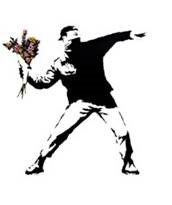23/12/2019
October 2019 saw the opening (and closing) of graffiti artist Banksy’s pop–up shop, Gross Domestic Product, in Croydon. Like most things associated with the artist, the store has generated a significant amount of publicity in the mainstream press including the Guardian, BBC and Time Out.
A number of intellectual property publications have also taken an interest in the case as, according to the artist, the main motivation behind the opening of the store was, “possibly the least poetic reason to ever make some art” – a trade mark dispute.
The specific case that is at the centre of the dispute is an EUTM cancellation action, specifically an application for invalidity of EU trade mark no. 012575155. The trade mark that is the subject of the application is a representation of one of Banksy’s more famous murals, shown below:

The piece, known as ‘Flower Thrower’, was originally painted in 2005 on a wall in Jerusalem (specifically, on the side of a garage on the main road to Beit Sahour, Bethlehem) and reflects the artist’s well publicised pacifist / anti-war sentiments.
The trade mark was approved for registration in August 2014. The application to invalidate the mark was brought before the EUIPO in March this year. The action has been brought on the basis that the mark is non-distinctive and/or descriptive.
The Parties
The party bringing the application to cancel the trade mark is north Yorkshire based company, Full Colour Black (‘FCB’), which describes itself as, “a contemporary Art Licensing company specialising in the commercialisation of world famous street art.” Until recently, the section of its online store which sold reproductions of Banksy’s artwork was entitled ‘We Love Banksy’ although this wording now appears to have been removed. The company primarily sells greeting cards, the vast majority of which contain reproductions of artistic works of various graffiti artists (although notably not, at the time of writing, the Flower Thrower).
The owner of the EUTM Registration is a company named Pest Control Office Limited (‘PCO’), which it is understood is the corporate entity through which Banksy operates.
The present action is not the first dispute between these parties, FCB having applied to invalidate UK trade mark registration no. 2457210 for the mark ‘BANKSY’ in 2012. This trade mark is still registered.
The position under Copyright
If the dispute was in relation to the infringement of Banksy’s copyright in the Flower Thrower work, via the use by FCB on a greeting card that used the artistic work, there is little doubt that Banksy would be successful. An artwork protected by copyright cannot be reproduced or distributed without the permission of the author (or the owner of the copyright if it is not the original artist – for example if the artist has assigned the copyright to another party).
However, it is clear from FCB’s responses to comments on this matter in social media that it considers that it is free to use Banksy’s artistic works because:
i) It uses photos of Banksy’s artworks in the creation of its gift cards and has “fully licenced” the use of the photo from the photographer;
ii) that because Banksy’s works are “graffiti” in the “public domain”, they can be freely used; and
iii) that Banksy himself has taken something of a laissez faire attitude to copyright and has stated previously that the general public is free to reproduce and use his works for their own enjoyment and that his permission is not required for this.
On all counts FCB appear misguided. The law in England and Wales gives graffiti or street artists intellectual property rights just like other artists. There is nothing in the Copyright Designs and Patent Act 1988 that explicitly denies the extension of copyright in street art, and in the only High Court case in the UK to consider copyright in graffiti – Creative Foundation v Dreamland [1] (which incidentally also involved a mural by Banksy) – Judge Arnold (as he then was) had no hesitation in finding that the copyright in the work in question belonged to the artist. It also should go without saying that using an exact reproduction of an artistic work, such as a photo or digital copy, does not allow the user to circumvent the copyright of the original artist.
The third point is interesting as there is obviously be some degree of tension in the position of an artist who has previously claimed “copyright is for losers” were they to subsequently to seek to rely on these rights. However, suggesting, as both FCB and some commentators have, that in stating “copyright is for losers”, Banksy has somehow absolved himself of rights that are guaranteed by statute is clearly no argument at all. Furthermore, implicitly allowing members of the general public to reproduce an artistic work for personal enjoyment is not the same thing as consenting to a company mass producing and commoditising that same work.
The trade mark position
Although the position under copyright is clear, as discussed above, this is not a copyright dispute. In addition to the rights that exist in all of Banksy’s works, PCO have registered a number of Banksy’s artistic works as trade marks at the EUIPO. It is very likely that Banksy and/or his legal team prefer to use trade marks as opposed to copyright as part of their enforcement strategy as it enables the artist to act via his company, PCO, rather than in his personal capacity (these trade marks were used earlier this year as part of an action to close down an unauthorised exhibition selling “unofficial” Banksy merchandise in Italy). In order to bring an action for copyright based upon one of his artworks, Banksy would have to identify himself as the author of the piece, which would lead to him revealing his identity on legal documentation.
As most people know, Banksy’s identity is a secret (as is the case with practically any graffiti artist in the world, for fairly obvious reasons) and given he has managed to maintain his anonymity for the best part of 20 years despite his work achieving worldwide acclaim, it seems unlikely that he would disclose his identity for the purposes of bringing a copyright action.
PCO have been filing EU trade mark applications for Banksy’s artistic works since 2014 (including ‘Balloon Girl’ and the ‘Laugh Now’ Monkey), all of which have now proceeded to registration. What prompted FCB to attempt to cancel one of these marks has not been disclosed, although given the voracious criticism of Banksy that FCB have been making via social media and the press, one suspects that had FCB received a letter before action from Banksy’s representatives, they would have informed the media of this. According to FCB, it attempted to pay royalties to Banksy / PCO for the use of his works, but Banksy refused these. As above, the parties have clearly been known to each other for some time, and it seems almost certainly that Banksy would, at the very least, voiced his disapproval of FCB’s activities at some point in the previous seven years, but why FCB have brought the action at this juncture has not been reported.
FCB have essentially argued that the Flower Thrower is not capable of functioning as a trade mark because i) consumers would view it as a famous art work rather than a badge of origin; and ii) because the market for merchandise with reproductions of Banksy’s art work on them has become flooded with unauthorised copies, the trade mark would not be capable of designating the origin of any authorised products. [2]
Leaving aside that the authorities that FCB have relied upon in support of these arguments are both UK decisions that are unlikely to be considered anything more than informative by the EUIPO [3] (and will be discounted altogether if Brexit happens prior to a decision being handed down), the argument as to whether a work of art can also function as a trade mark is an interesting one. FCB’s position appears to be that art works are prima facie non distinctive for all goods, because consumers would view them as works of art and not signs that designate origin, but particularly so for goods that would have the work of art is their subject matter. For example, a work of art could not function as a trade mark for an art print, as the mark would constitute the subject matter of the goods and would, in effect, be descriptive of such goods.
The above being said, works of art have been accepted as trade marks on previous occasions by the EUIPO – Keith Haring’s ‘Radiant Baby’ and ‘Barking Dog’ and Edvarch Munch’s ‘The Scream’ (among others) are all registered by the artists, their estates, or corporate bodies associated with them, in relation to Class 16 goods. In addition, as PCO’s marks are registered, they enjoy the presumption of validity meaning that FCB would have to show to the satisfaction of the EUIPO that registration should not have been permitted at the time that application for the mark was made. Whether FCB’s more generalised arguments will be directly applicable enough to do so remains to be seen.
The other main strand of FCB’s argument is that Banksy would be viewed by consumers as an artist and not a retailer of goods. This, according to FCB, is reinforced by the fact that the relevant marketplace has been flooded with unauthorised goods bearing Banksy’s artwork, therefore consumers no longer expect goods bearing the artwork to come from the original source. This aspect of the case leads, finally, to Banksy’s Gross Domestic Product store.
A number of publications have reported that to own a trade mark it has to be used in commerce and therefore, the reasoning behind the Gross Domestic Product store is to provide Banksy / PCO with evidence of use. While as a general rule this is broadly correct, trade mark owners have a ‘grace period’ of five years to bring their marks into use, and PCO’s mark was not five years old at the time that FCB’s cancellation action was brought. FCB’s action was therefore not based on non-use, and the question of whether PCO’s trade marks have been used in commerce is not the primary issue in this case. Much has been made of the fact that Banksy and/or his advisors have seemingly misunderstood the legal position in relation to genuine use in opening the Gross Domestic Product store (the World Trade Mark Review’s headline was ‘‘’A frankly pointless step” – why Banksy pop-up shop could hinder trademark case’ [4]). However, the numerous comments made about the perceived ‘token’ nature of the use Gross Domestic Product store are beside the point, and from a slightly more removed perspective, opening the store does not seem ‘pointless’ at all.
One of the central premises of FCB’s second argument is that Banksy is known as an artist and not as a retailer of goods. The publicity surrounding the opening of the Gross Domestic Product store has clearly established that Banksy has sold products that bear his marks and therefore that there is a ‘legitimate’ source for such goods. While there is the obvious argument that this use would have commenced after the action was brought and therefore would be too late to be material in this particular case, the registration at issue is not the only trade mark that Banksy / PCO owns (at the time of writing the Flower Thrower trade mark has been refiled at the EUIPO). This argument also does not take into account that authorised Banksy merchandise has in fact been available via the ‘Walled Off Hotel’ ‘gift shop’ for a number of years and therefore the GDP shop could legitimately be seen as an extension of these ‘retail’ activities. Additionally, Banksy becoming a recognised retailer of products strengthens his / PCO’s position under the law of passing off.
How this particular case will resolve remains to be seen. One suspects that it will be decided primarily on the issue of whether an artwork can also function as a trade mark (on which there are arguments both ways). However, the impression overall is that this case is only a part of a wider dispute and that Banksy may now be taking a more active role in the protection of his intellectual property than may previously have been the case [5]. It would therefore not be surprising if FCB’s days of being able to sell products affixed with Banksy’s artwork were numbered.
What most certainly has been surprising, however, is the nature of the reporting of this case and how one-sided it has been. The matter involves two parties – one a world renowned artist and the other a company that profits from selling unauthorised reproductions of the artist’s work. FCB are also entirely transparent in relation to their business model. As noted above, its website refers to the company as one which “specialises in the commercialisation of world famous street art”. It just appears that none of the ‘commercialisation’ is of benefit to any of the artists involved. Furthermore, when (presumably) asked by the artist to cease infringing, FCB’s response was to effectively smear Banksy in the press and on social media, essentially calling him an out of touch millionaire who was bullying a small business and ignoring his “real fans” by attempting to make unauthorised copies of his work unavailable to buy. FCB even accuse Banksy of concocting a “bleeding heart story” to garner more support (Banksy has confirmed that all of the profits of the GDP store will be donated to funding the humanitarian charity operating the ‘Open Arms’ migrant rescue boat). [6]
Despite this however, the majority of articles (including some by legal academics) have chosen to focus upon the perceived ‘David v Goliath’ aspect of the matter and how unfairly a small ‘local business’ is being treated by an international artist, somewhat conveniently forgetting that it is FCB that have commenced the legal action in this matter. One commentator has even stated, bizarrely, that Banksy had somehow “forfeited his copyright” by refusing to accept royalty payments from FCB.
Other publications have chosen to focus on the perceived ‘hypocrisy’ of Banksy in asserting his intellectual property rights when he had previously asserted that ‘copyright is for losers’ and stated that the general public were authorised to do as they pleased with his works. This completely ignores the fact that an artist allowing members of the general public to recreate or use his or her art for their own enjoyment is entirely different from that artist consenting to the mass production and commercialisation of that same work.
It would have to be said that if accusations of hypocrisy are to be levelled at any party in this dispute, it is FCB that appear the more deserving. It is almost impossible to square the behaviour of a company who purport to “love” Banksy, but commence legal action against him when he (presumably) requests that it stops making and selling unauthorised reproductions of his work. As one of the commentators under FCS’s ‘Public Statement Release’ on Facebook succinctly puts it:
“If he doesn’t want you to use it then morally you should stop using his work, forget all the legal stuff, just do what’s right”.
It is difficult to disagree.
Footnotes:
[1] [2015] EWHC 2556 (Ch) (11 September 2015).
[2] FCB ran additional arguments based on bad faith that are outside the scope of this post and seem unlikely to be material in any event.
[3] In fact, UK precedent actually diverges from EU jurisprudence on this particular point.
[4] It should be noted that this article was effectively an interview with FCB’s trade mark representative and may not correspond to the World Trade Mark Review’s own position.
[5] See also: http://ipkitten.blogspot.com/2019/03/milan-court-sides-with-banksy-in.html
This article is for general information only. Its content is not a statement of the law on any subject and does not constitute advice. Please contact Reddie & Grose LLP for advice before taking any action in reliance on it.


